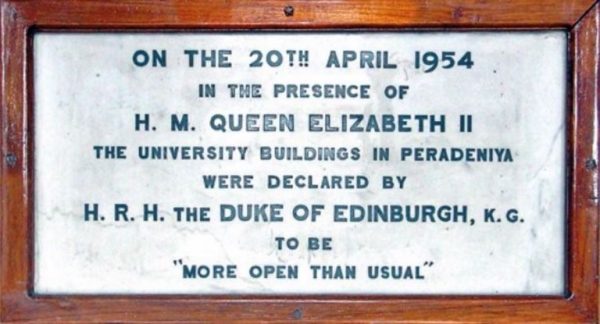Prince Philip’s Indelible ‘Marks’ in Sri Lanka

Source:Thuppahis
Photo courtesy of my old student pal Piyasiri Wickramasekara ….more details below
 The Old 1935 Standard Nine said to be purchased by Prince Philip when serving in the Royal Navy in Ceylon in 1935 and now placed in the Museum of the Galle Face Hotel –— Pix courtesy of Bruce Rawlings [see below] …. However, Prince Philip was born in 1921 and could not have been driving cars at that moment — so, someone else has concoted a tale that has been swallowed hook, line and majestic sinker.
The Old 1935 Standard Nine said to be purchased by Prince Philip when serving in the Royal Navy in Ceylon in 1935 and now placed in the Museum of the Galle Face Hotel –— Pix courtesy of Bruce Rawlings [see below] …. However, Prince Philip was born in 1921 and could not have been driving cars at that moment — so, someone else has concoted a tale that has been swallowed hook, line and majestic sinker.
PERADENIYA UNIVERSITY and the ROYAL Visit of INAUGURATION
It does not demand any deep acumen for one to deduce that the induction of the British Royals was ‘engineered’ by the founding father of Peradeniya University, Sir Ivor Jennings and the Duke’s hand here was a companion act to the tamasha surrounding Queen Elizabeth’s visit to Kandy and to Trinity College. In other words, both sets of ceremonial genuflection to the ‘British order’ from a former crown colony mark the ‘amusing’ contraditions within the island’s history.
To end our reflection here, however, would be a disservice. For one: we must recognise the Duke of Edinburgh’s sharp wit when he inducted the inauguration and Jennings’s endorsement of this with witha plaue. Quite brilliant these two acts together. Both the spacing of buildings at Peradeniya University then in the 1950s and the care taken to ’embrace’ them with fauna and flora of magnificent ‘texture’ bespoke an artistic flair. The setting and its reshaped ‘texture’ was/is partly the work of a great mind. That was Sir Ivor Jennings, — who had pressed for Peradeniya as the site from the 1940s and pursued the venture diligently. He had arrived in the island in 1942 as the head of University College (in Colombo) with “a mandate to creat a university.” As noted in Wikipedia, the “institution, on the model of University of London, was dubbed the University of Ceylon and was first established in Colombo, the capital city, then partially transferred in 1952 to a purpose-built campus in Peradeniya.”
That Jennings was able to secure this impact was due in large part to his friendship with DS Senanayake and Sir Oliver Goonetilleka. While heading University of Ceylon he had a second official post as “Deputy Civil Defense Commissioner” from 1942-45. Thus n the years 1942-48 he was one of the hands that manoeuvred Ceylon’s independence from the United Kingdom in circumstances where India was the prime focus of London’s problems.
Given the political and military complexities of that decade, any historical appraisal would have to conclude that the political manouevres of the threesome beween 1942 and 1948 were awesome.
Note, too, that Jennings was not from British aritocratic stock. A “middle class’ and educated gentleman yes, but not one with a plum in his mouth. In doffing my hat to him therefore I drive the point home by providing several references and several illustrations of the ‘landscape’ that confirm Prince Philip’s smart characterisation of the place.
 The “Senate Building” where the Plaque conveying Prince Philip’s opening gesture stands ….
The “Senate Building” where the Plaque conveying Prince Philip’s opening gesture stands …. 
 Jennings walks the length of Peradeniya Campus with the Student Union President as his departing memento …. and his role is recognised with a statue unveiled on the 6th December 2017 …. on a world stage where statues of Cecil Rhodes and other imperialists are being assailed and an island stage where Sinhala chauvinists are assailing the British colonial sins of the 19th century in defensive reactions to contemporary HR accusations & lies directed at the alleged outcomes of Eelam War IV.
Jennings walks the length of Peradeniya Campus with the Student Union President as his departing memento …. and his role is recognised with a statue unveiled on the 6th December 2017 …. on a world stage where statues of Cecil Rhodes and other imperialists are being assailed and an island stage where Sinhala chauvinists are assailing the British colonial sins of the 19th century in defensive reactions to contemporary HR accusations & lies directed at the alleged outcomes of Eelam War IV.
It is hardly surprising that even today some elements among the island’s elite chose to recoginize Jennings’ place in the educational firmament by erecting a statue in his honour at the place where his imprint was so great.













